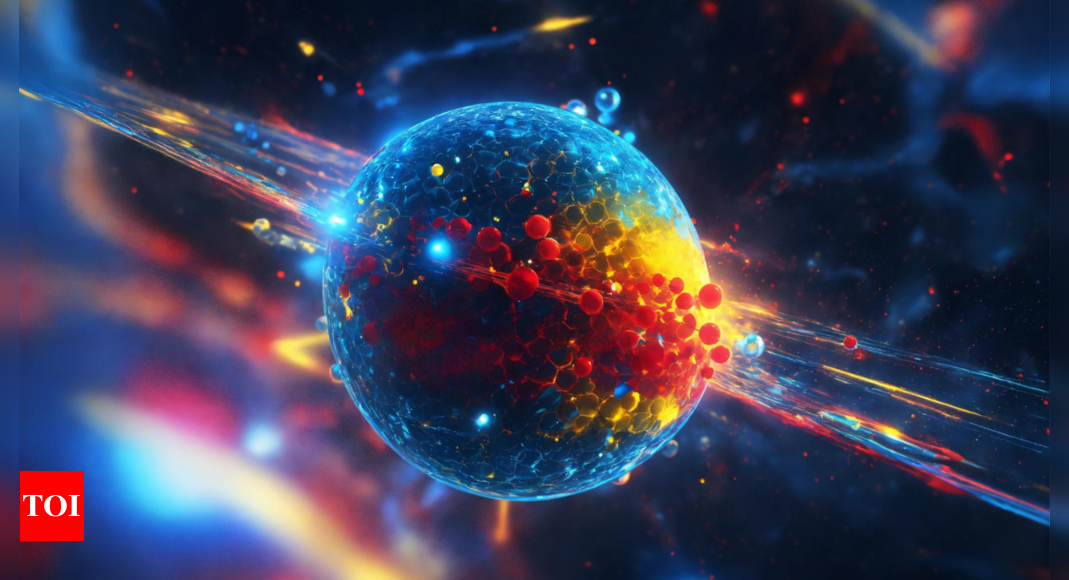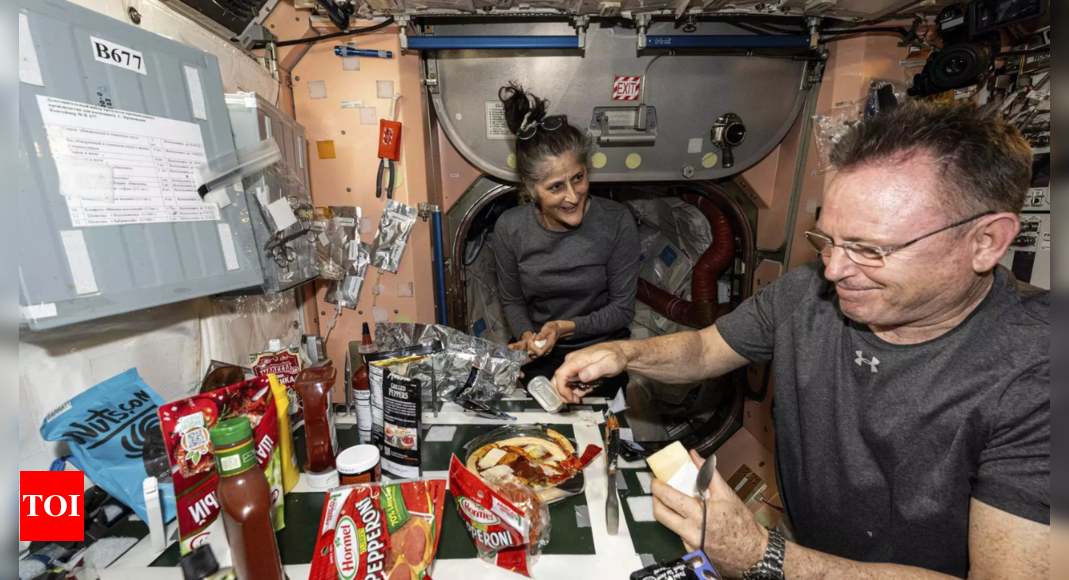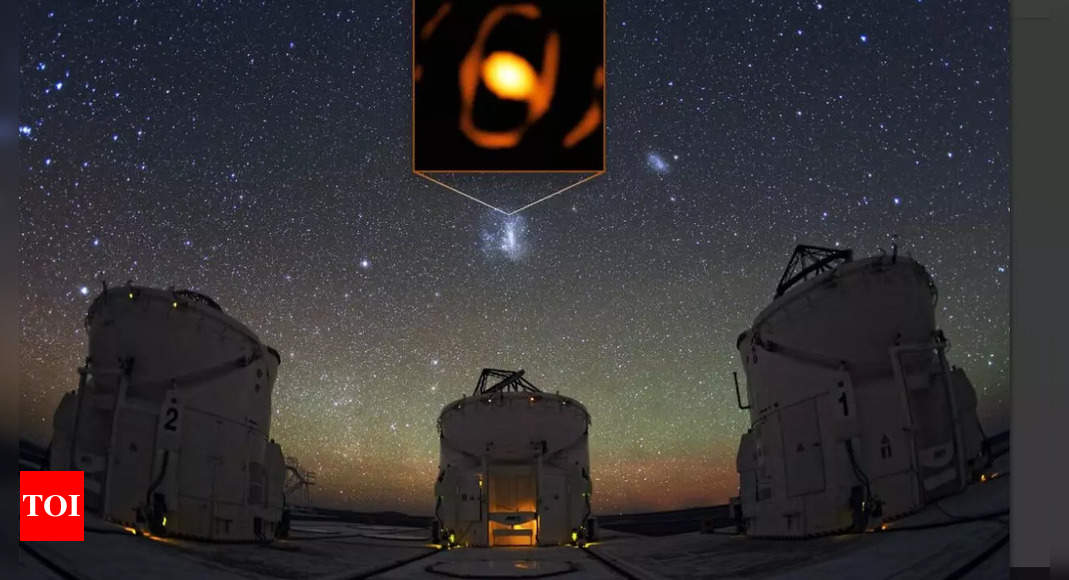
SYDNEY: One of the most surprising predictions of physics is entanglement, a phenomenon where objects can be some distance apart but still linked together. The best-known examples of entanglement involve tiny chunks of light (photons), and low energies.
At the Large Hadron Collider in Geneva, the world’s largest particle accelerator, an experiment called Atlas has just found entanglement in pairs of top quarks: the heaviest particles known to science.
What is entanglement?
In everyday life, we think of objects as being either “separate” or “connected”. Two balls a kilometre apart are separate. Two balls joined by a piece of string are connected.
When two objects are “entangled”, there is no physical connection between them – but they are not truly separate either. You can make a measurement of the first object, and that is enough to know what the second object is doing, even before you look at it.
The two objects form a single system, even though there is nothing connecting them together. This has been shown to work with photons on opposite sides of a city.
The idea will be familiar to fans of the recent streaming series 3 Body Problem, based on Liu Cixin‘s sci-fi novels. In the show, aliens have sent a tiny supercomputer to Earth, to mess with our technology and to allow them to communicate with us. Because this tiny object is entangled with a twin on the alien homeworld, the aliens can communicate with it and control it – even though it is four light-years away.
That part of the story is science fiction: entanglement doesn’t really allow you to send signals faster than light. (It seems like entanglement should allow you to do this, but according to quantum physics this isn’t possible. So far, all of our experiments are consistent with that prediction.)
But entanglement itself is real. It was first demonstrated for photons in the 1980s, in what was then a cutting-edge experiment.
Today you can buy a box from a commercial provider that will spit out entangled pairs of photons. Entanglement is one of the properties described by quantum physics, and is one of the properties that scientists and engineers are trying to exploit to create new technologies, such as quantum computing.
Since the 1980s, entanglement has also been seen with atoms, with some subatomic particles, and even with tiny objects undergoing very, very slight vibrations. These examples are all at low energies.
The new development from Geneva is that entanglement has been seen in pairs of particles called top quarks, where there are vast amounts of energy in a very small space.
So what are quarks?
Matter is made of molecules; molecules are made of atoms; and an atom is made of light particles called electrons orbiting a heavy nucleus in the centre, like the Sun in the centre of the solar system. We already knew this from experiments by about 1911.
We then learned that the nucleus is made up of protons and neutrons, and by the 1970s we discovered that protons and neutrons are made up of even smaller particles called quarks.
There are six types of quark in total: the “up” and “down” quarks that make up protons and neutrons, and then four heavier ones. The fifth quark, the “beauty” or “bottom” quark, is about four-and-a-half times heavier than a proton, and when we found it we thought it was very heavy. But the sixth and final quark, the “top”, is a monster: slightly heavier than a tungsten atom, and 184 times the mass of a proton.
No one knows why the top quark is so massive. The top quark is an object of intense study at the Large Hadron Collider, for exactly this reason.
We think the very large mass may be a clue. Maybe the top quark is so massive because the top quark feels new forces, beyond the four we already know about. Or maybe it has some other connection to “new physics”.
We know that the laws of physics, as we currently understand them, are incomplete. Studying the way the top quark behaves may show us the way to something new.
So does entanglement mean that top quarks are special?
Probably not. Quantum physics says that entanglement is common, and that all sorts of things can be entangled.
But entanglement is also fragile. Many quantum physics experiments are done at ultra-cold temperatures, to avoid “bumping” the system and disturbing it. And so, up to now, entanglement has been demonstrated in systems where scientists can set up the right conditions to make the measurements.
For technical reasons, the top quark’s very large mass makes it a good laboratory for studying entanglement. (The new ATLAS measurement would not have been possible for the other five types of quark.)
But top quark pairs won’t be the basis of a convenient new technology: you can’t pick up the Large Hadron Collider and carry it around. Nevertheless, top quarks do provide a new kind of tool to conduct experiments with, and entanglement is interesting in itself, so we’ll keep looking to see what else we find.
At the Large Hadron Collider in Geneva, the world’s largest particle accelerator, an experiment called Atlas has just found entanglement in pairs of top quarks: the heaviest particles known to science.
What is entanglement?
In everyday life, we think of objects as being either “separate” or “connected”. Two balls a kilometre apart are separate. Two balls joined by a piece of string are connected.
When two objects are “entangled”, there is no physical connection between them – but they are not truly separate either. You can make a measurement of the first object, and that is enough to know what the second object is doing, even before you look at it.
The two objects form a single system, even though there is nothing connecting them together. This has been shown to work with photons on opposite sides of a city.
The idea will be familiar to fans of the recent streaming series 3 Body Problem, based on Liu Cixin‘s sci-fi novels. In the show, aliens have sent a tiny supercomputer to Earth, to mess with our technology and to allow them to communicate with us. Because this tiny object is entangled with a twin on the alien homeworld, the aliens can communicate with it and control it – even though it is four light-years away.
That part of the story is science fiction: entanglement doesn’t really allow you to send signals faster than light. (It seems like entanglement should allow you to do this, but according to quantum physics this isn’t possible. So far, all of our experiments are consistent with that prediction.)
But entanglement itself is real. It was first demonstrated for photons in the 1980s, in what was then a cutting-edge experiment.
Today you can buy a box from a commercial provider that will spit out entangled pairs of photons. Entanglement is one of the properties described by quantum physics, and is one of the properties that scientists and engineers are trying to exploit to create new technologies, such as quantum computing.
Since the 1980s, entanglement has also been seen with atoms, with some subatomic particles, and even with tiny objects undergoing very, very slight vibrations. These examples are all at low energies.
The new development from Geneva is that entanglement has been seen in pairs of particles called top quarks, where there are vast amounts of energy in a very small space.
So what are quarks?
Matter is made of molecules; molecules are made of atoms; and an atom is made of light particles called electrons orbiting a heavy nucleus in the centre, like the Sun in the centre of the solar system. We already knew this from experiments by about 1911.
We then learned that the nucleus is made up of protons and neutrons, and by the 1970s we discovered that protons and neutrons are made up of even smaller particles called quarks.
There are six types of quark in total: the “up” and “down” quarks that make up protons and neutrons, and then four heavier ones. The fifth quark, the “beauty” or “bottom” quark, is about four-and-a-half times heavier than a proton, and when we found it we thought it was very heavy. But the sixth and final quark, the “top”, is a monster: slightly heavier than a tungsten atom, and 184 times the mass of a proton.
No one knows why the top quark is so massive. The top quark is an object of intense study at the Large Hadron Collider, for exactly this reason.
We think the very large mass may be a clue. Maybe the top quark is so massive because the top quark feels new forces, beyond the four we already know about. Or maybe it has some other connection to “new physics”.
We know that the laws of physics, as we currently understand them, are incomplete. Studying the way the top quark behaves may show us the way to something new.
So does entanglement mean that top quarks are special?
Probably not. Quantum physics says that entanglement is common, and that all sorts of things can be entangled.
But entanglement is also fragile. Many quantum physics experiments are done at ultra-cold temperatures, to avoid “bumping” the system and disturbing it. And so, up to now, entanglement has been demonstrated in systems where scientists can set up the right conditions to make the measurements.
For technical reasons, the top quark’s very large mass makes it a good laboratory for studying entanglement. (The new ATLAS measurement would not have been possible for the other five types of quark.)
But top quark pairs won’t be the basis of a convenient new technology: you can’t pick up the Large Hadron Collider and carry it around. Nevertheless, top quarks do provide a new kind of tool to conduct experiments with, and entanglement is interesting in itself, so we’ll keep looking to see what else we find.









